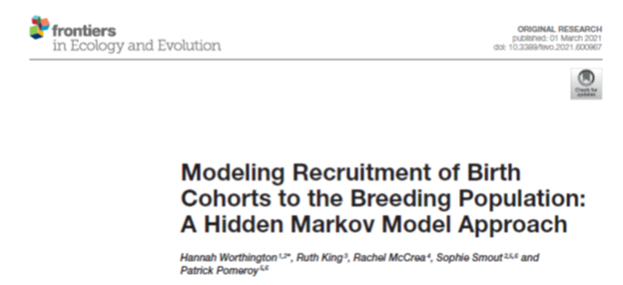Rachel McCrea and co-authors from St Andrews and Edinburgh have published a paper on modelling the recruitment process of gray seals.
The full paper is available open access here: https://www.frontiersin.org/articles/10.3389/fevo.2021.600967/full
Modeling Recruitment of Birth Cohorts to the Breeding Population: A Hidden Markov Approach
Worthington, King, McCrea, Smout and Pomeroy
Long-term capture-recapture studies provide an opportunity to investigate the population dynamics of long-lived species through individual maturation and adulthood and/or
time. We consider capture-recapture data collected on cohorts of female gray seals
(Halichoerus grypus) born during the 1990s and later observed breeding on the Isle
of May, Firth of Forth, Scotland. Female gray seals can live for 30+ years but display
individual variability in their maturation rates and so recruit into the breeding population
across a range of ages. Understanding the partially hidden process by which individuals
transition from immature to breeding members, and in particular the identification of
any changes to this process through time, are important for understanding the factors
affecting the population dynamics of this species. Age-structured capture-recapture
models can explicitly relate recruitment, and other demographic parameters of interest,
to the age of individuals and/or time. To account for the monitoring of the seals from
several birth cohorts we consider an age-structured model that incorporates a specific
cohort-structure. Within this model we focus on the estimation of the distribution of
the age of recruitment to the breeding population at this colony. Understanding this
recruitment process, and identifying any changes or trends in this process, will offer
insight into individual year effects and give a more realistic recruitment profile for the
current UK gray seal population model. The use of the hidden Markov model provides an
intuitive framework following the evolution of the true underlying states of the individuals.
The model breaks down the different processes of the system: recruitment into the
breeding population; survival; and the associated observation process. This model
specification results in an explicit and compact expression for the model with associated
efficiency in model fitting. Further, this framework naturally leads to extensions to more
complex models, for example the separation of first-time from return breeders, through
relatively simple changes to the mathematical structure of the model.

